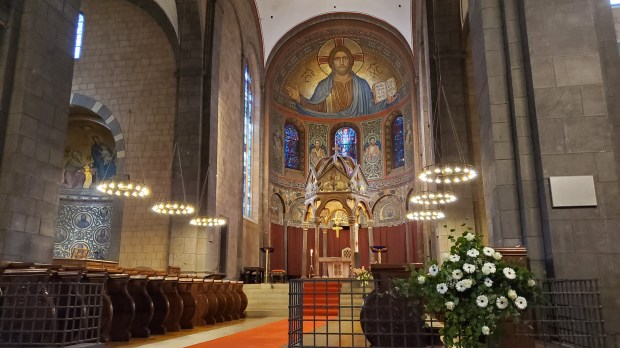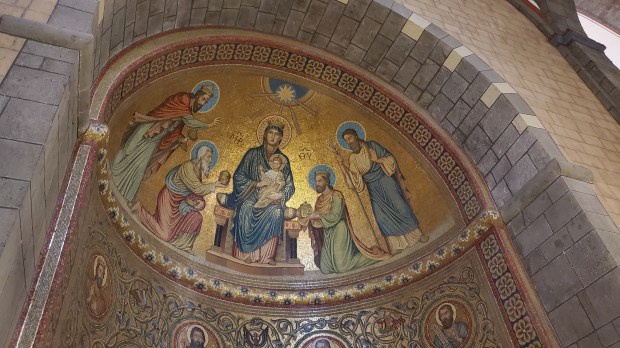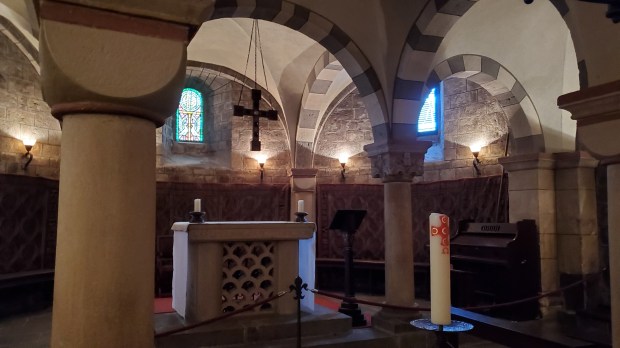Maria Laach Benedictine Abbey sits on an ancient volcanic lake in Germany’s upper Rhineland, just outside the wine country on the banks of the Rhine and Moselle Rivers. The abbey, a famous example of Romanesque style, is nearly 1,000 years old and offers a beautiful space of prayer as well as lovely views of Germany’s Eifel hill country and delicious food and drink.
Maria Laach was originally founded in 1093 under the patronage of Heinrich II von Laach, who is buried in the main church. It constitutes one of the few remaining examples of original Romanesque architecture north of the Alps. While other, richer abbies underwent extensive renovations in the Baroque period, Maria Laach, which was of more modest means, retained much of its external appearance through the modern period. The most important external renovation — a garden and covered path leading to the entrances of the church, called a paradisum — dates to 1225.

Six towers rise from the abbey church — three larger ones on the east side, and two smaller ones from the east and one from the cupola. The bell tower houses the largest carillon in the Rhineland. It contains 14 bells, the largest of which dates to the 19th century.
The main church has the structure of an old Roman basilica, with a long nave leading to the central transepts and sanctuary. Choir stalls for the monks line the sanctuary before the main altar.

Dissolved in 1802
Monks continuously occupied the abbey until 1802, when French forces occupied the area and secularized religious houses. The Benedictines did not return until 1892, and the following year they legally re-established the abbey as a monastic community. In the intervening years, much of the original decoration of the interior church was destroyed by occupiers — some of the only remaining original art includes the baldachin above the altar and the grave of Heinrich II.
The Jesuits used the property, though not the main church, as a residence and house of studies from 1862 to 1872 and added a library which is still today filled with 260,000 volumes. The abbey celebrates their resettlement each year on November 25, the feast of St. Catherine.

The Liturgical Movement
After its re-foundation, the abbey served as an important center of the Liturgical Movement in Germany, a theological movement whose ideas largely precipitated the reforms of the Second Vatican Council. Among the new community was Anselm Schott, OSB, a famed liturgist who published translations of the Missal in German for use by the laity at Mass — even today, the Schott Missal (Schott Messbuch in German) is the most common hand missal throughout Germany.
The Beuron abbey was also known for its experiments in blending Western and Byzantine art styles, and this artistic heritage can be seen in the mosaics that presently adorn the interior of Maria Laach and the paintings which ring its sacristy. The abbey was also home to other liturgical scholars such as Father Odo Casel and Abbot Ildefons Herwegen.
During the Hitler era, unfortunately, some at the abbey had close philosophical ties with the Nazis and with antisemitism. The monastery was not closed down, as other Benedictine foundations were under the Nazis, but eventually the monks came under pressure from the Gestapo. The abbey welcomed the end of the Third Reich; however, this period remains a controversial one in the abbey's history.

The monastery today
Today, the abbey houses a community of around 25 monks. The surrounding area is filled with shops that sell religious art, gardening supplies, and locally-produced beer and wine. The Klostergaststätte restaurant offers a fantastic view of the abbey. The abbey guest wing and the Seehotel Maria Laach provide overnight accomodations. The lake is a mere 10 minute walk from the abbey, and visitors can rent boats or explore its banks on hiking trails. Pilgrims can join the monks for Mass and the Liturgy of the Hours, chanted in Latin and German, throughout the day.
Maria Laach is accessible from nearby Koblenz, a short train ride from Cologne or Frankfurt, by bus, train, or taxi. From the Koblenz Hauptbahnhof, take a 15-minute train to Andernach. From there, take the line 395 towards Mendig Niedermendig Mendig Bahnhof, which stops at Maria Laach.



